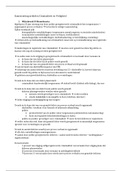Summary
AQA A level Psychology Approaches Summary Notes/ Essay Plans
- Module
- Approaches in psychology
- Institution
- AQA
These are A/A* summary notes/essay plans for AQA A level Psychology, the topic approaches in psychology. They can be used for 6 mark, 16 mark or 12 mark questions. I wrote them textbooks as well as revision guides. The essay plans clearly show A01 and A03. The essay plans are colour coded, blue re...
[Show more]












